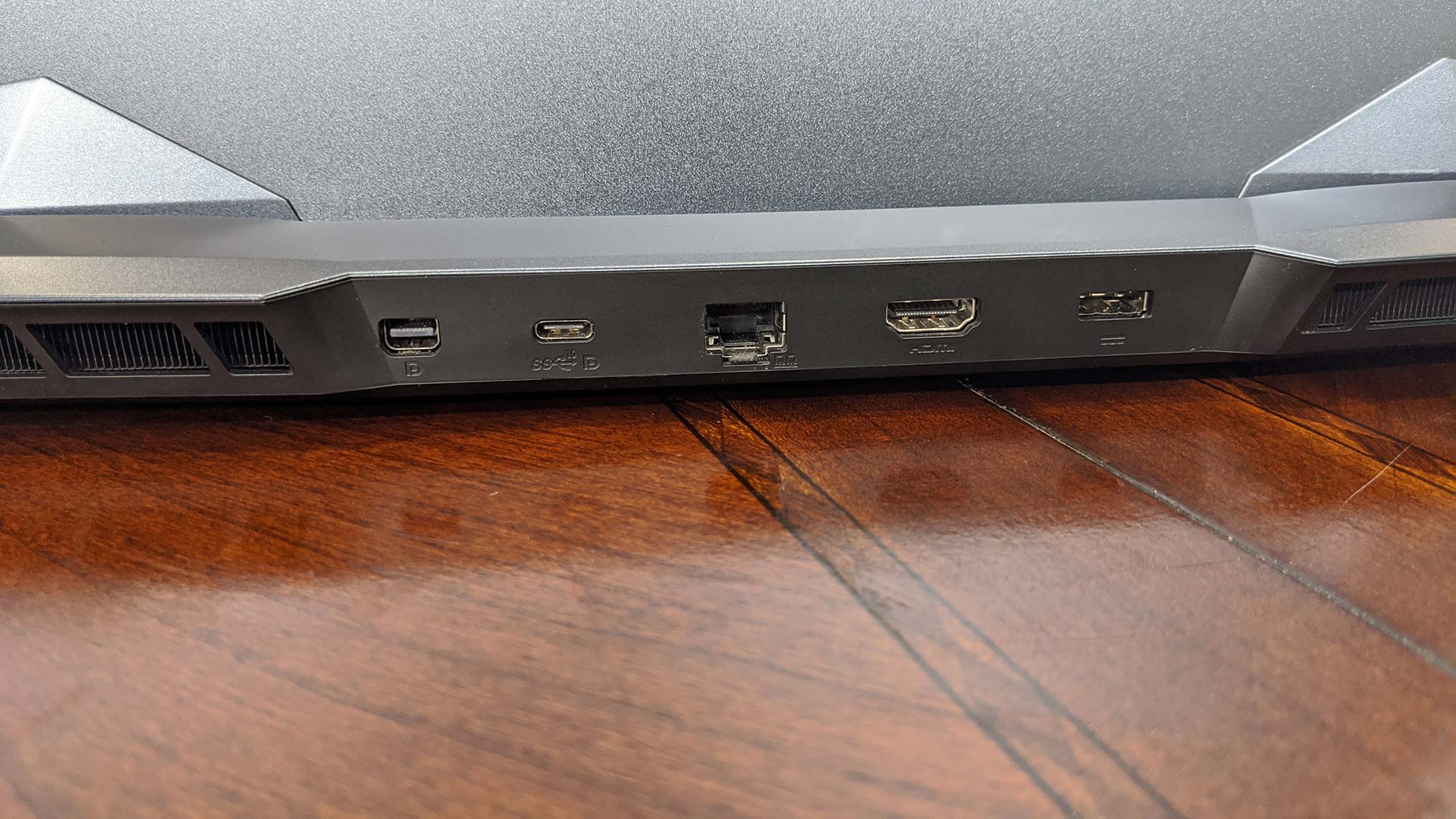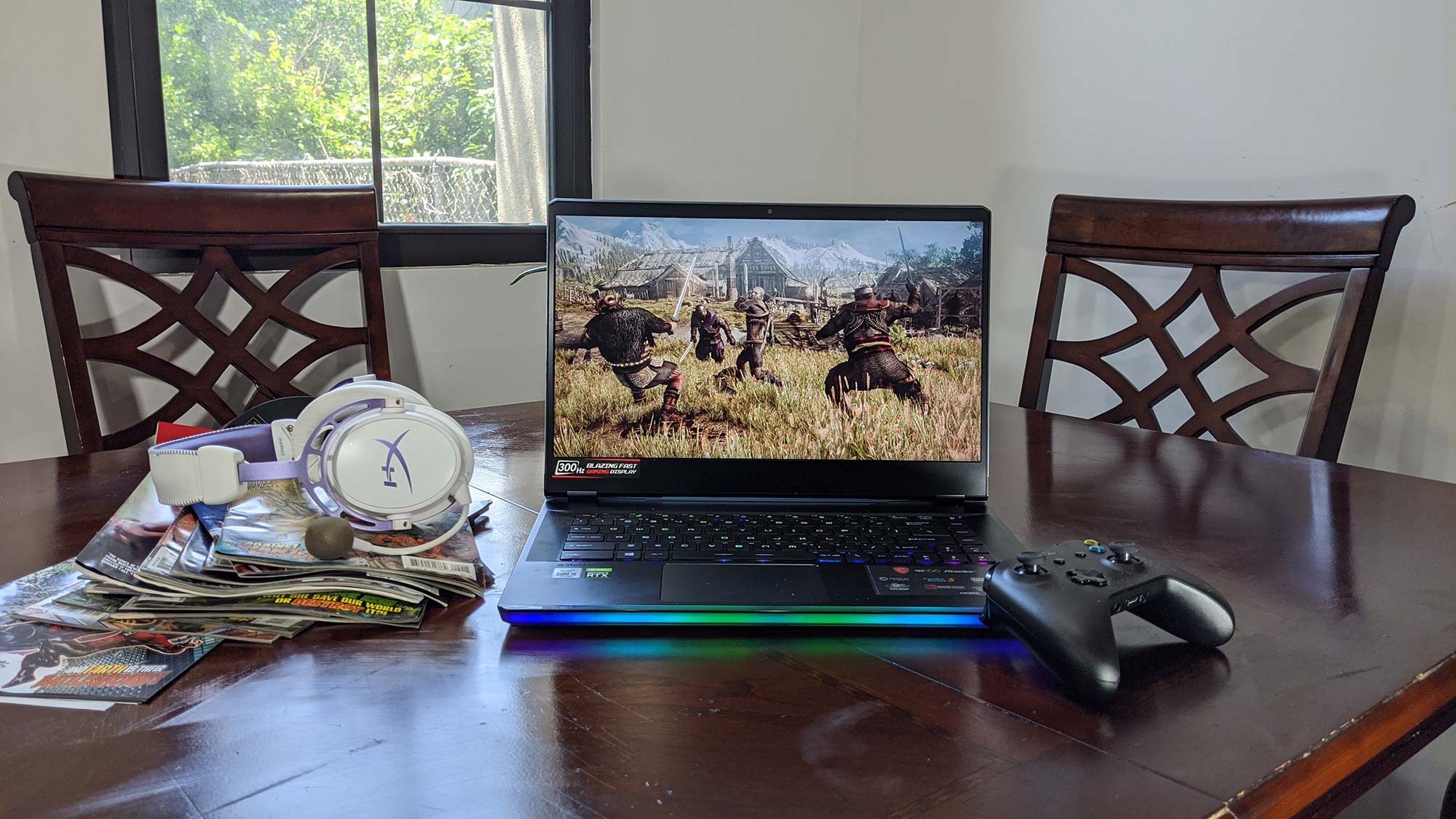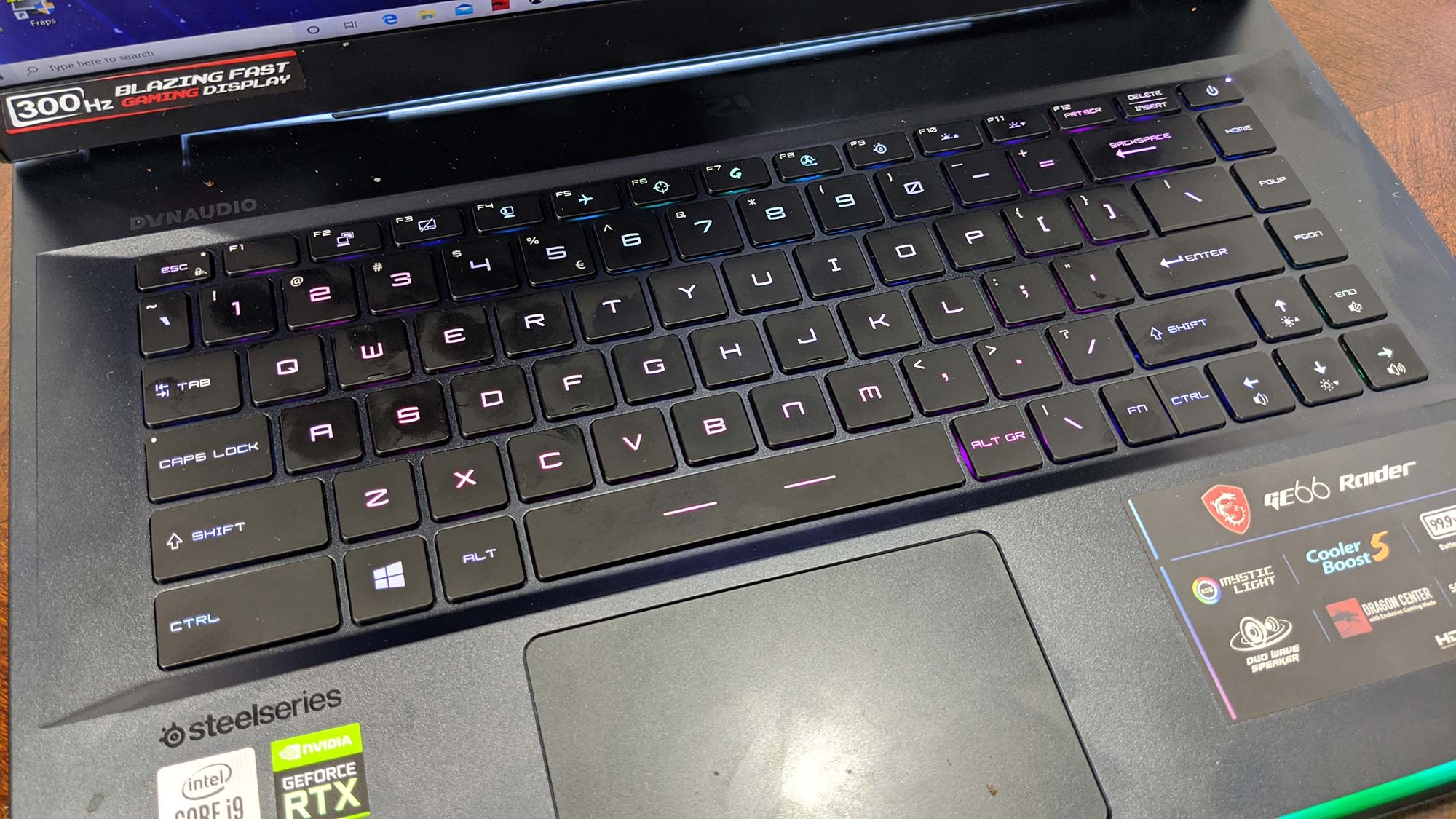Laptop Mag Verdict
The MSI GE66 Raider packs the power and speed of a desktop replacement into a more manageable 15-inch chassis.
Pros
- +
Stellar graphics and overall performance
- +
Solid battery life
- +
Blazing fast SSD
- +
Excellent webcam
Cons
- -
Weak audio
- -
Runs hot
Why you can trust Laptop Mag
Is there ever such a thing as too much power? If you ask MSI, the answer is an emphatic no, especially in the case of its latest laptop, the MSI GE66 Raider. At $2,999, the Raider packs specs you’d expect to see in the likes of the GT76 Titan. This baby’s outfitted with an overclockable Intel Core i9 processor and an Nvidia 2080 Super GPU.
Plus, it’s got an SSD serving up blink-and-you’ll-miss-it speeds and a pretty display. However, the audio quality needs work and the keyboard could have better feedback. But if you’re looking for the most powerful 15-inch in the land and the latest entrant to our best gaming laptops page, look no further.
MSI GE66 Raider pricing and configurations
The base model of the Raider will set you back $1,899, but you’ll get a 2.3-GHz Intel Core i7-10875H processor with 16GB of RAM, a 512GB NVMe SSD, an Intel UHD Graphics GPU, an Nvidia GeForce RTX 2070 GPU with 8GB of VRAM and a 1920 x 1080p display with a 240Hz refresh rate and a 3-millisecond response rate.
Need more power? Then you’ll want to take a look at the $2,199 model, which bumps you up to a 2.6-GHz Intel Core i7-10750H CPU, 32GB of RAM and a 1TB NVMe SSD. For $2,499 you make the leap to an RTX 2080 Super Max-Q GPU.
I quested to save the world on the $2,999 model, which gave me access to 2.4-GHz Intel Core i9-10980HK processor and a 1920 x 1080 display with a 300Hz refresh rate and 3ms response rate. If you want to save a couple of hundred bucks, go for the $2,799, which knocks you down to a 2.3-GHz Intel Core i7-10875H processor.
MSI GE66 Raider design
The Raider looks like a baby MSI GT76 Titan and there’s absolutely nothing wrong with that. It’s a beautiful laptop consisting of a granite gray aluminum lid, black metal siding and a black plastic undercarriage. The lid is bare save for the regal dragon sigil at the top. The reinforced hinges and rear panel sport a bunch of aggressive angles that give the impression the system is on the verge of transforming.
The laptop’s interior is primarily made from onyx-colored aluminum that’s cool and smooth to the touch. The keyboard resides in a slight recess above the touchpad and palm rest. The display is surrounded by relatively thin bezels on the sides but MSI could stand to trim the fat on the top and bottom borders, particularly the bottom. But my absolute favorite part of the laptop is the thick glass prism at the front lip of the laptop. MSI calls it the Aurora, and when the RGB lighting pulses through, it looks like an undulating river of color –– exactly like a mini Aurora Borealis.
Sign up to receive The Snapshot, a free special dispatch from Laptop Mag, in your inbox.
Weighing 5.3 pounds, the 14.1 x 10.5 x 0.9-inch Raider is heavier than the Aorus 15G (4.9 pounds, 14 x 9.8 x 1 inches) and the Acer Predator Triton 500 (4.8 pounds, 14.1 x 10 x 0.7 inches). It’s lighter than the Razer Blade Pro 17 (6.1 pounds, 15.5 x 10.2 x 0.8 inches), but that’s to be expected since it’s a 17-inch system.
MSI GE66 Raider ports
Ports, ports, everywhere! MSI loaded up the Raider with ports, including a pair of USB Type-A 3.2 Gen 1 ports and a 3-in-1 card reader on the right side. Along the left side, there’s a USB Type-A 3.2 Gen 2 port, a Thunderbolt 3 port and a headset jack. Check out the back of the system and you get another USB Type-C port, a Mini DisplayPort 1.4, a Gigabit Ethernet input, HDMI 2.0 and a proprietary charging port.
MSI GE66 Raider display
Anti-glare for the win! I took the Raider’s 15.6-inch, 1920 x 1080 screen into the backyard to work on the review and my tan. The color remained as vibrant outdoors as it was indoors. That meant when I watched the 1080p trailer for Miss Juneteenth, actress Nicole Beharie’s nice brown skin shone against her burgundy top as did the small piece of turquoise in her golden necklace. The details were so sharp that the gentle waves of her curl pattern gave the impression of an ebony sea flowing from her scalp with thin bands of red and gold.
Will you immediately notice how much better a 300Hz refresh rate and 3ms response rate makes your gameplay? Probably not. But it makes all the difference with image rendering. I get the most out of it when I’m playing shooters like The Division 2 or Borderlands 3 because there’s little to no lag. And when it comes to placing those headshots, my accuracy is much better at 300Hz compared to a regular 60Hz screen.
But to take in some truly breathtaking vistas, I played The Witcher 3: Wild Hunt and basked in a glorious sunset. As the sun rose, the sky slowly transitioned from rose pink to orange to gold and finally a stunning baby blue, all the while Geralt’s ash white hair billowed in the breeze.
Measuring for color reproduction, we discovered that the panel only reproduced 114% of the sRGB color gamut. Well, not only, because it’s better than our 100% minimum. That result matches the Aorus but fails to meet or surpass either the 139% premium gaming laptop average or the Predator (117%) and the Blade (119%).
The laptop did a little better on the brightness test. The Raider’s screen averages 300 nits, which falls short of the 345-nit category average and the Blade’s 304 nits. However, the Raider is still brighter than the Aorus (243 nits) and the Predator (277 nits).
Something I want for all laptops in 2020 is thinner bezels. The Raider’s sides are barely there while the top is noticeably thicker. However, the bottom chin is massive (all the better to show off that glossy MSI logo m’dear).
MSI GE66 Raider audio
I like the idea of side-mounted speakers as they help create an illusion of surround sound. However, the execution isn’t as good as I hoped –– at least when Nahimic’s surround sound effect isn’t enabled. But even when it is turned on, the audio from the Dynaudio DuoWave speakers gives me the impression that I’m listening to an old-school FM radio. So while Janelle Monae’s sexy vocal sounded OK, the bass was weak and the electric guitar sounds tinny even when I tried shifting through the Nahimic software presets (Music, Movie, Communication and Gaming).
When I played through Witcher 3, I started with the Gaming setting on the Nahimic software, but ultimately stuck with the Music setting as it gave me the best result. But no matter which setting I used, the music took a backseat to the sound effects, even when I adjusted the in-game audio settings. That meant the strong winds, rustling leaves and violently whipping branches of the storm I was seeking refuge from was crystal clear.
However, when I encountered a band of bandits, the usually rousing violins, shouts and drums were nowhere near as loud as they should have been. I almost had focus on the music to really hear it. If MSI can find a way to add more oomph to the speakers, it’ll have a serious winner on its hands. But for now, it’s just OK and I’d recommend investing in a great gaming headset.
MSI GE66 Raider keyboard and touchpad
The Raider’s island-style keyboard is a mixed bag. On one hand, it’s almost as clicky as a mechanical keyboard with deep travel. However, when I actually pressed down on the rather large, glowing keys, it was a bit mushy. Still, I managed to reach my normal 70 words per minute on the 10fastfingers typing test.
MSI GE66 Raider gaming, graphics and VR
“[Sherri], What is best in life?”
“To crush your enemies, see them driven before you, and to hear the lamentations of their women!” –– Conan the Barbarian
You can do all that and more with the Nvidia GeForce RTX 2080 Super Max-Q GPU with its 8GB of video memory. At least that’s what it felt like when I was cutting down a group of wraiths in The Witcher 3: Wild Hunt, I gracefully darted between the undead, strategically striking and casting spells until they disintegrated into piles of ash at a silky smooth 108 frames per second on Ultra. The frame rate jumped to 146 fps on High.
The Raider lived up to its name on our synthetic benchmarks, pillaging its competitor’s bounty on the Shadow of the Tomb Raider test. The notebook got 109 fps, shattering the 71-fps premium gaming laptop average. The Blade and its RTX 2080 Super Max-Q GPU came the closest to keeping pace with the Raider at 98 fps. The Predator, which also has a RTX 2080 Super Max-Q GPU reached 66 fps while the Aorus and its RTX 2070 Super Max-Q GPU hit 83 fps.
When we ran the Grand Theft Auto V benchmark, the Raider achieved 91 fps, cruising past the 85-fps category average. The Blade was hot on its heels with 89 fps, the Aorus reached 76 fps while the Predator reached 60 fps.
On the Far Cry New Dawn test, the Raider produced 99 fps, handily beating the 85-fps average as well as the Blade and the Aorus, which scored 87 fps. With the Metro: Exodus (DirectX 11-RTX) benchmark, the Raider hit 58 fps sailing past the Blade (54 fps), Aorus (52 fps) and 55-fps average.
And if you’re interested in hooking up a VR headset to the laptop, have at it. During the VRMark Cyan test, the Raider scored 8,423, surpassing the 4,766 average. The Blade notched 8,056 while the Aorus hit 6,575.
MSI GE66 Raider performance
MSI is serving up power on the gaming and multitasking front. The Raider’s 2.4-GHz Intel Core i9-10980HK processor and 32GB of RAM is lean, mean and overclockable. But it’s a powerful piece of silicone even when it’s at its normal clock speed. I watched an episode of Queer Eye on Netflix while running 32 additional tabs in Google Chrome, some of which were playing videos on YouTube, Twitch and Mixer as well as Tweetdeck.
The Raider proved to be an absolute beast during our synthetic tests, starting with Geekbench 4.3. On our overall performance benchmark, the laptop shredded the competition hitting 32,767. The score is much higher than the 26,538 premium gaming laptop average. Equipped with Core i7-10875H CPUs, the Aorus and Blade reached 28,508 and 22,810, respectively while the Predator and its Core i7-8750H processor produced 20,990.
Running the Handbreak test, the Raider transcoded a 4K video to 1080p in 6 minutes and 59 second, smoking the 8:48 average. The Aorus was a minute behind at 7:59 with the Blade right behind at 9:31 with the Triton finished with a time of 11:04.
The Raider’s 1TB NVMe PCIe SSD is incredibly fast. It duplicated 4.97GB of multimedia files in 0:03 second which translates to a 1,458.2 megabytes per second. It smoked the 944.1MBps category average along with the Blade (848MBps, 512GB PCIe NVMe SSD) and Aorus (658MBps, 512GB SSD). However, the Predator and its dual NVMe PCIe SSDs managed to surpass the Raider with a result of 1,696.4MBps.
MSI GE66 Raider battery life
Similar to its slim cousin, the MSI GS66 Stealth, the Raider is outfitted with a 99.9-watt hour battery, the largest the TSA will allow on a flight. That helped the laptop last 4 hours and 57 minutes on the Laptop Mag Battery Test which consists of continuous web surfing over Wi-Fi at 150 nits of brightness.
The time was enough to outlast Blade’s 4:41, the 4:19 premium gaming laptop average and the Predator’s 3:04, but not the Aorus which clocked in at 6:16.
MSI GE66 Raider heat
When you’re packing all those powerful, high-end specs, you’re going to need an equally strong cooling system to keep everything at optimal temperature. To combat overheating, MSI has fine-tuned its custom Cooler Boost system. Now in its 5th iteration, Cooler Boost 5 consists of several copper pipes that are wider than previous iterations and two fans with 53 blades per fan which should allow for more efficient cooling.
So how’d Cooler Boost perform? I spent 15 minutes exploring the site of a bloody battle in Witcher 3, fighting off undead horrors. When I measured the touchpad, it had a temperature of 85 degrees Fahrenheit which is below our 95-degree comfort threshold. However, the center of the keyboard and undercarriage reached 108 and 125 degrees. However, thanks to the plastic bottom, the heat didn’t feel as intense as I expected when I used it in my lap.
MSI GE66 Raider webcam
The integrated 1080p on the Raider is one of the best I’ve seen on a laptop in a long time. The test photos I took captured the exact color of my mustard shirt with its white stripes. And with high resolution, you can see the ribbing in my sweater and almost make out the tweed pattern in my black and white couch.
MSI GE66 Raider software and warranty
MSI bundles all its branded utilities in its Dragon Center hub. In addition to customizing the lighting on the keyboard and light strip, this is also where you can adjust fan, CPU and GPU clock speeds. You can also switch between performance modes, display color temperature, enable/disable the webcam, Windows and Fn keys. This is also where you access Crosshair display, which allows you to create a custom crosshairs for your favorite shooters.
Third-party gamer-centric apps include Nvidia GeForce Experience, which has its own suite of utilities designed to enhance your gaming experience such as Battery Boost, Whisper Mode and Gamestream for when you’re ready to livestream. The laptop also has Killer Control Center which prioritizes network bandwidth for data-intensive software.
If you’re interested in creating content, the Raider comes preinstalled with CyberLink software such as AudioDirector, ColorDirector, PhotoDirector and PowerDirector. There’s also Music Maker Jam.
There is of course, some bloatware such as Candy Crush Friends and Farm Saga Heroes.
The MSI GE66 Raider ships with a 1-year limited warranty including 1-year global coverage. See how MSI fared on our annual Tech Support Showdown and Best and Worst Brands reports.
Bottom Line
With the MSI GE66 Raider, you get the power of a desktop replacement in a more portable 15-inch chassis. For $2,999, you get a gaming laptop packed to the gills with power thanks to an overclockable Intel Core i9 processor and Nvidia 2080 Super GPU. It’s an undeniable powerhouse whether you’re questing or crunching numbers –– it’s definitely one of the most powerful 15-inch gaming laptops on the market. And it’s got good battery life for a gaming laptop.
However, I wish the display was more vivid and brighter. And the audio quality definitely leaves much to be desired. If those things are priorities, I’d recommend the $3,199 Razer Blade Pro 17 although you’ll lose some of that top-notch performance. But for gamers in pursuit of power, the MSI GE66 Raider sits at the pinnacle.

Sherri L. Smith has been cranking out product reviews for Laptopmag.com since 2011. In that time, she's reviewed more than her share of laptops, tablets, smartphones and everything in between. The resident gamer and audio junkie, Sherri was previously a managing editor for Black Web 2.0 and contributed to BET.Com and Popgadget.








